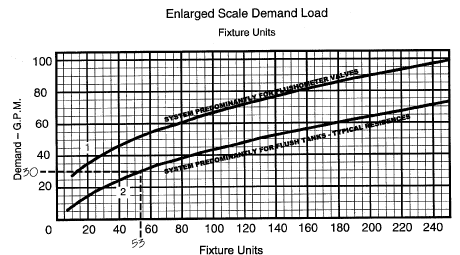Fixture Counts Calculator
Click here to get code
CALCULATING THE ESTIMATED WATER FLOW DEMAND IN GALLONS PER MINUTE (G.P.M.):
Estimate the supply demand by totaling the fixture units from the Water Customer Demand Data Table – Fixture Unit Count and then by reading the corresponding ordinate from chart below. Read chart vertically until you intersect the correct curve, then read the chart horinzontally until you read your water flow demand in G.P.M.
CURVE 1 (Top): SYSTEM PREDOMINANTLY FOR FLUSHOMETER VALVES
CURVE 2 (Bottom): SYSTEM PREDOMINANTLY FOR FLUSH TANKS – TYPICAL RESIDENCES







